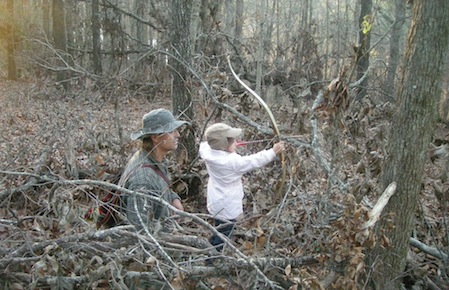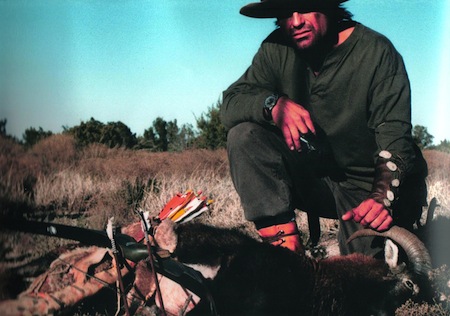
We are talking about hundreds of hours and sometimes several years spent in the field trying to kill a deer; doe or buck. Some rifle hunters may spend a few mornings out there and be done. We may have seen 120 deer by the time we finally get an arrow in the air and still, a lot of the time, not be able to make a kill. We practice year round, two or sometimes three or more times per week, because shooting a lot of arrows with your longbow or recurve gives you confidence and nothing could be more important than that out there. You may get one or two shots at a deer the whole season and that was it, and you had better make it count. We have to pass far more shot opportunities than other hunters, knowing we may not get another one. We have to hunt harder and longer than anyone else, and our killing percentages are usually lower than the others.
To stay truly traditional is part of the challenge. Of course, everyone sets their own limitations. Every technological advance we use gets us further away from the real experience. It is not even worth the space to write them down; there are too many of them–even for the traditionalist. As time goes by there seems to be more ways to make it easier on us. At some point you need to say enough is enough and let technology bypass you.
To go two or three seasons meatless just means we will not have the pleasure to eat our own harvest. But to our forefathers it meant everything. They could not afford to go a season without killing at least two or three big game animals. The consequences of this would be starvation and possibly death. Therefore they had to be the ultimate hunters or else not even mess with it. Native Americans that did not make good hunters either became camp handymen, gatherers, medics, or maybe even wardens or warriors. But if they had what it took to make a good bowhunter, they were priceless to their people since subsistence depended on them a lot of the time. You see, men and women with other trades were going to get their job done for the most part no matter what. But hunters never knew for sure when they were going to be successful at bringing in meat and pelts to camp. They would take off hunting for weeks at the time, and probably would not come back until they had something to show for their efforts. Coming back empty handed was a really bad omen and they got everyone worried and thinking hard to come up with solutions.
Hunting the hard way means truly putting yourself on the line every day. For 365 days out of the year you do some of it either in your mind or physically. We are always trying to get better at it. Don’t take the shortcut (technology, gadgets, gear too advanced to make it easier on yourself), just get better at what you do:
1. Become a better hunter (all styles: ambush, still hunter, spot and stalk, etc…)
2. Develop more patience and persistence. These two attributes alone will sooner or later pay off big dividends.
3. Pray to make the right choices out there when you are on your own. It is so easy to do the wrong thing when we are not being watched. Traditional Bowhunting is often times a lonesome affair. Since there are not as many of us, you don’t always find hunting partners to go with. I, for one, do 99% of all my hunting on my own. Even when you embark yourself on a hunt with a friend, you usually are on your own come crunch time.
4. Be thankful for what you do and the opportunity to share the wild in this awesome world.
5. Become a better shot. More accuracy will increase your chances of success. And remember, practice does not make perfect, perfect practice makes perfect. This means try to integrate into your practice sessions: different distances, different angles, different postures, and different backgrounds. When out there slinging arrows at targets or roving, nothing is more important than keeping your eye on the smallest, tiniest spot you can discern out on your target, whatever it is. This should be second nature, meaning, you should do it automatically, without even thinking about it.
6. Practice at longer ranges. Increase your range by five yards. Be honest about it. You cannot do this overnight. You need to train for at least three months at the longer ranges to have any degree of confidence.
7. Fine tune your equipment. By this I don’t mean go get yourself more gadgets. Simply, make better arrows, out of wood if you can, make sure they are very straight when you go out hunting. Fine tune your bow to maximum efficiency and quietness. Make sure your broadheads are very sharp. If you can tolerate it, use a 16 strand Dacron string opposed to Fast Flight, it will be quieter. Assure yourself of checking your brace height all the time. It is part of the challenge. Use heavy arrows. For big game 700 plus grains is almost mandatory with traditional equipment.
8. Be aware of wind direction and speed at all times. If wind direction changes on you, give it a few minutes before getting out and re-positioning yourself. Sometimes wind will go back to what it was doing to begin with.
9. When getting in and out of tree stands and ground blinds, be quiet and discreet. Try to disturb your hunting area as little as possible.
10. Develop the ability to stay out longer by learning to deal with the elements better. Learn to stay warm when cold, cool when hot and humid. Be prepared to deal with rain or snow.
 All in all what I am saying is that in order to become a better traditional bowhunter you have to improve your woodsmanship. This is easier said than done. Simply put, you just have to pay your dues by spending a lot of time in the woods.
All in all what I am saying is that in order to become a better traditional bowhunter you have to improve your woodsmanship. This is easier said than done. Simply put, you just have to pay your dues by spending a lot of time in the woods.
Hunting the hard way should not mean anything else but exactly what it infers. Be in your stand or hunting area 30 minutes to an hour before first light. Hunt long hours for as long as you can possibly go. A lot of bowhunters fall short in this department by hunting the morning until 9 am or so only, and going back to hunting too late in the day for an hour and a half or so. You need to go back out as early as possible, and you should obviously stay well past dawn. When adequate, you should hunt all day long. If done ambush hunting in the morning, go still hunting or glassing and stalking for a couple of hours in the early afternoon. This really pays off on windy and rainy days when ground blinds and tree stands don’t produce as much action because, for the most part, animals are bedded. The sense of accomplishment from downing an animal while still hunting on foot has no equal. You can also go scout a new area. Have lunch out there in the field. Maybe build a fire to either heat your meal or cook it, or just to keep warm and cozy during your midday break. There is a lot to be said about the bowhunter that does this routinely. Try to have at least a short practice session every day during hunts; maybe right after lunch break. Carry two or three judo pointed arrows for this purpose. It does not take long to find some thick bush, or stump where you can unload 60 or 70 arrows. When appropriate, just go stump shooting in an area where you will not disturb the game you are after. This is not only fun but and it will give you a sense of confidence and accomplishment. Another midday activity could also be to improve one or two of your tree stands or ground blinds. Tree stands work better if some background foliage is added to them. Ground blinds can always be improved by adding more brush and foliage as well as maybe clearing one or two new shooting lanes. Another good and necessary midday activity is to update your journal. If done regularly, this should not take more than a few minutes and it is a pleasure to do it sitting near your camp fire. A hunting journal provides you with a good source of information for later reference.
In closing, let me just say how fortunate and blessed we are to have been enlightened to be inclined to traditional bowhunting. Very few out there in the field come even close to the experience and level of self communion with nature and wild things that we chose for ourselves. And this is the ultimate privilege. Don’t ever give in to other styles of hunting. Don’t ever let go of the fulfilling atavism and self satisfaction of traditional bowhunting. The question remains: Why would anyone have it any other way?
Brief Author’s Bio: Manuel Sebastian Cervantes is originally from Mexico where he has bowhunted whitetails and other game in the States of Jalisco, Colima, Chihuahua, Durango and Sonora since 1982. In the US he has hunted in New Mexico, Texas, Missouri, Iowa and Arkansas. He lives in Northwest Arkansas (since 2007), with his wife Carmen, and five year old daughter Anasazi, where he works as a Tennis Professional. When not hitting tennis balls with Junior Players he is out in the woods chasing whitetails. Manuel Sebastian has bowhunted exclusively with recurves and longbows in the 40# to 80# range, and uses wood arrows and single blade broadheads. Manuel Sebastian has a private bow collection of over 40 bows including some primitive ones of his own make; and in his archery library you can find just about everything that has ever been written on classical archery and traditional bowhunting.


Leave A Comment